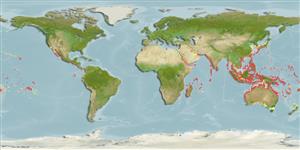Common names from other countries
Environment: milieu / climate zone / depth range / distribution range
Ecologia
; intervalo de profundidade 0 - 30 m (Ref. 349). Tropical
Indo-Pacific: East Africa to western Polynesia.
Length at first maturity / Tamanho / Peso / Idade
Maturity: Lm ? range ? - ? cm Max length : 7.0 cm SHL macho/indeterminado; (Ref. 349); common length : 4.5 cm SHL macho/indeterminado; (Ref. 349)
Collected in some areas for food and local shellcraft (Ref. 349). Abundant in all kinds of habitats, especially under rocks in turbid water near vital reefs. Populations living in quiet waters tend to develop thinner, more inflated and less callous shells than those inhabiting rough waters (Ref. 349). Members of the family Cypraeidae are primarily carnivores (Ref. 67623).
Life cycle and mating behavior
Maturidade | Reprodução | Desova | Ovos | Fecundidade | Larvas
Members of the order Neotaenioglossa are mostly gonochoric and broadcast spawners. Life cycle: Embryos develop into planktonic trocophore larvae and later into juvenile veligers before becoming fully grown adults.
Poutiers, J.M. 1998. (Ref. 349)
Categoria na Lista Vermelha da IUCN (Ref. 130435)
Categoria CITES (Ref. 108899)
Not Evaluated
Not Evaluated
Ameaça para o homem
Harmless
Utilização humana
| FishSource |
Ferramentas
Mais informação
Idade/TamanhoCrescimentoComprimento-pesoComprimento-comprimentoMorfologiaLarvasAbundância
Fontes da internet
Estimates based on models
Preferred temperature
(Ref.
115969): 24.3 - 29.3, mean 28.3 (based on 3913 cells).
Vulnerabilidade
Low vulnerability (10 of 100).
Categoria de preço
Unknown.
